Shrimp disease is one of the factors causing failure that must be overcome during cultivation. What’s more, these diseases can also cause mass mortality which can lead to significant economic losses and decreased production.
Various influencing factors cause disease outbreaks, from pathogens, poor environmental conditions, and pond management to shrimp being carriers of shrimp that have previously been infected with the disease.
So, what types of diseases are often encountered during shrimp cultivation?
Types of Shrimp Diseases That Often Infect
1. White Spot Syndrome Virus (WSS)
White spot disease or white spot disease is a disease in vannamei shrimp that is highly contagious and deadly. A virus causes this disease from the crustacean group. In addition, environmental factors can also trigger white spot disease infection.
The appearance of white spots and redness on the shrimp’s body indicates early symptoms of white spot disease. Over time, shrimp attacked by this disease will die slowly because it causes them to lose their appetite and eventually die.
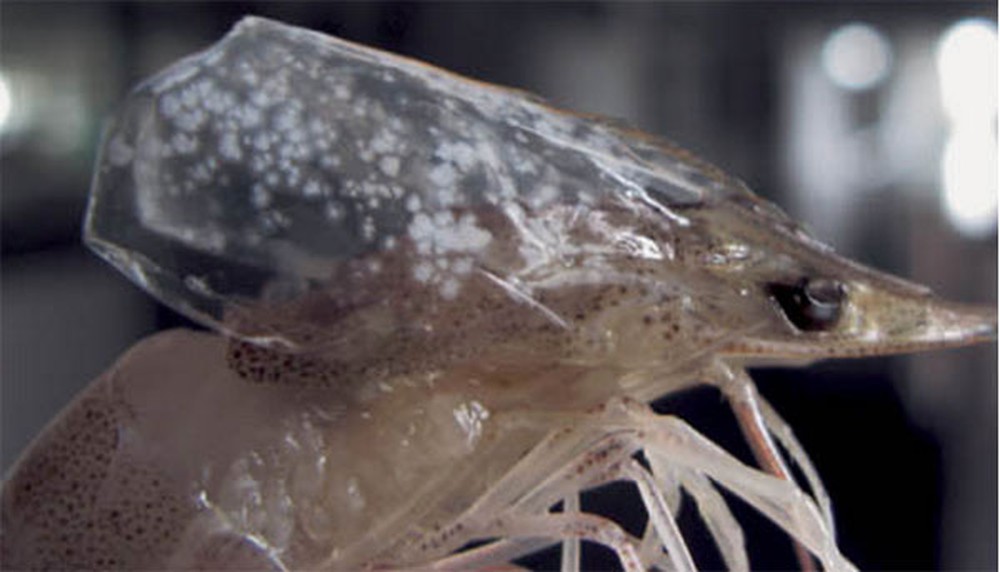
A shrimp infected with WSSV
However, the white spots are actually not a reliable sign to diagnose the disease because these can also be caused by environmental factors such as high pH of the water or even by some other bacteria. Shrimp affected by WSD exhibit a loss in appetite and abnormal swimming.
It is important that farmers check if the stock contains WSSV and to destroy the stock as soon as it is proven to be infected. The water quality must be kept in check, regularly cleaned, and monitored for possible infective sources.
2. Early Mortality Syndrome (EMS)
Early Mortality Syndrome (EMS), also known as Acute Hepatopancreatic Necrosis Disease (AHPND), is a disease that attacks pond shrimp and is characterized by sudden death, loss of appetite, and abnormal swimming behaviour. It is caused by Vibrio parahaemolyticus in Penaeid shrimp. It affects the post larval stage and can be diagnosed roughly 20-30 days after stocking.
This type of disease is the most frightening for shrimp farmers. This is because the death rate from EMS disease can reach 100% of the population.
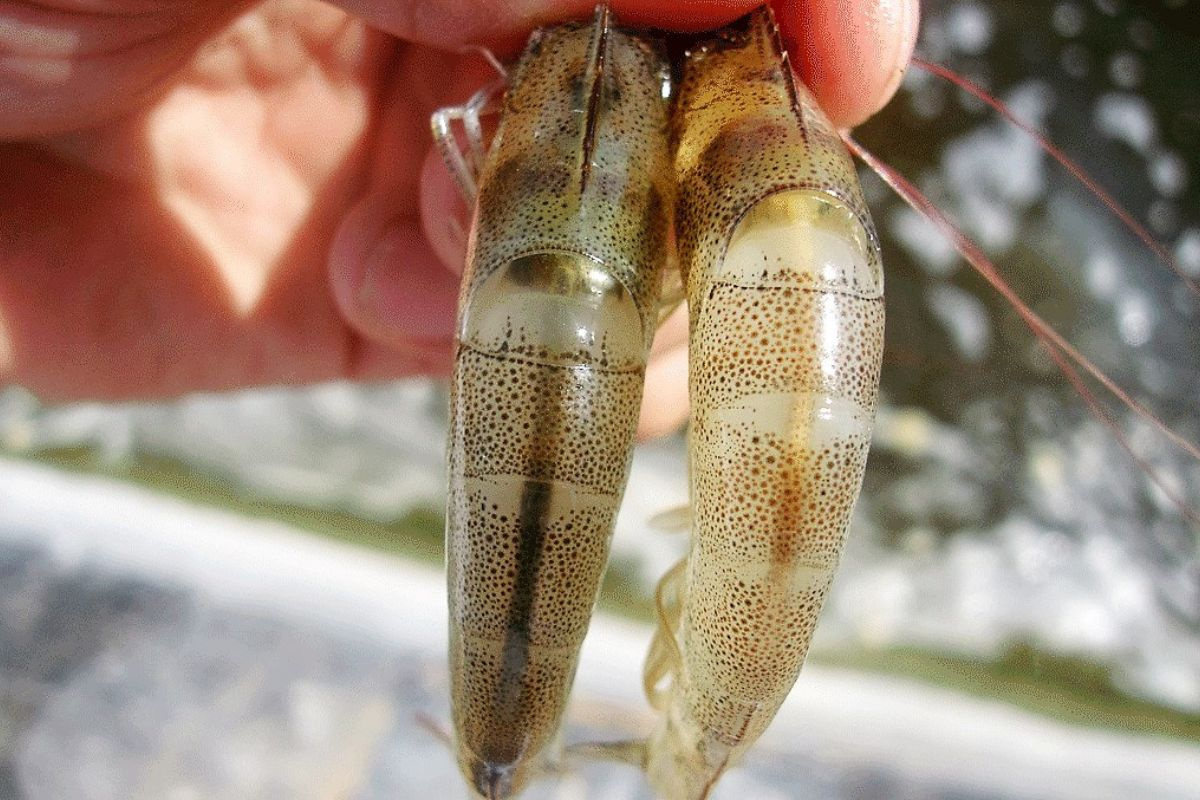
A shrimp infected with EMS (Early Mortality Syndrome)
To prevent, farmers need to focus on the quality broodstock and postlarvae (PL). Farm management practices, such as cleaning the pond bottom and preparing the pond water, determining the stocking density, choosing feeds and feeding practices, and monitoring water quality fluctuations must be observed as these were found to be connected to AHPND outbreaks. De Schryver et al. (2014) found that while it is important to disinfect ponds, it is recommended to grow the shrimp in water that has a biodiverse microbial system. This can be done by adding probiotics to the pond water.
3. Infectious Hypodermal and Hematopoietic Necrosis Virus (IHHNV)
Infectious Hypodermal and Hematopoietic Necrosis Virus is a type of disease caused by a virus that causes shrimp to experience defects in the abdomen and snout.
Shrimp infected with IHHNV will show signs of swimming behaviour to the surface of the water, then remain motionless and eventually sink to the bottom of the pond. This behavior will continue until the shrimp die.
A shrimp infected with IHHNV
Note: Deformity of the sixth abdominal segment.
Source: B Diggles
4. Taura Syndrome Virus (TSV)
Taura Syndrome Virus is a disease that first appeared in the Taura River, Ecuador. Meanwhile, transmission can occur through water and direct contact between shrimp or other crustaceans, carriers of the TSV virus.
The Taura Syndrome Virus has spread only in Colombia, Peru, Brazil, Hawaii, Texas, and Florida until now. Meanwhile, in Asia, no shrimp has been infected with this virus.
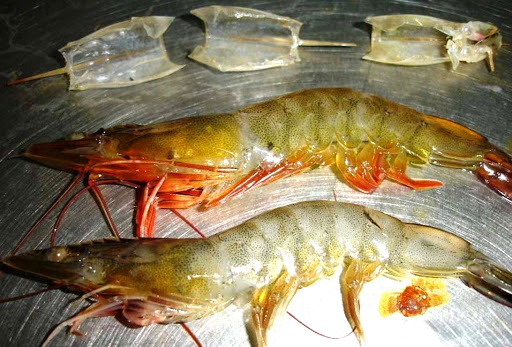
A shrimp infected with TSV
Source:mybinh
5. Vibriosis
Vibriosis is a type of shrimp disease caused by the attack of Vibrio sp. When shrimp are infected with vibriosis, symptoms will appear in a thin skin, black sores on the body, and incomplete shrimp limbs.
Vibriosis disease is no less deadly than other illnesses found in shrimp. The death rate caused by this disease can reach 85% of the population.
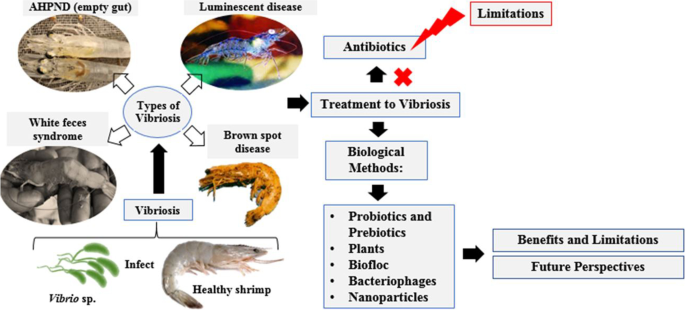
Source: link.springer.com
6. White Feces Disease
White feces disease, also known as white feces disease, was first detected in Indonesia in 2014. This type of disease causes the death of up to 40% of the total name shrimp intensive pond population.
Symptoms caused by shrimp infected with White Feces Disease include decreased appetite, shrimp intestines changing color to white and even looking empty due to lack of food intake, abnormal shrimp growth, and feces floating on the surface of the water.
Compared to a normal shrimp, the gut is pale white instead of a darkish brown color. The feces excreted by the shrimp is also more buoyant than normal as the white excrement floats to the surface of the pond. The exoskeleton of infected shrimp become loose, and there is a dark discoloration on the gills.
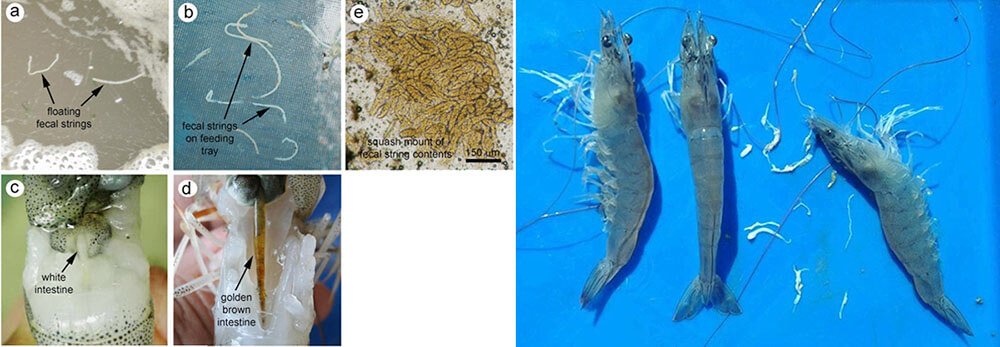
A shrimp infected with White feces disease
Source: internet.
Some growing practices such as high stocking densities and bad feed management have also been connected to the disease.
Since the exact cause of WFD is still unknown, it is best to follow biosecurity and water management best practices to reduce the risk of its occurrence.
7. Infectious Myonecrosis Virus (Myo/IMNV)
Infectious Myonecrosis Virus (IMNV) or Myo in vannamei shrimp is a type of disease that can cause mass death. Symptoms of shrimp infected with this disease are reddening of the lower segment of the shrimp’s tail. Then slowly, the shrimp will die and sink to the bottom of the pond.
Myo disease is caused by an RNA (Ribonucleic Acid) virus and is classified as malignant because it causes mass death in a short time when the shrimp are 60-80 days old.
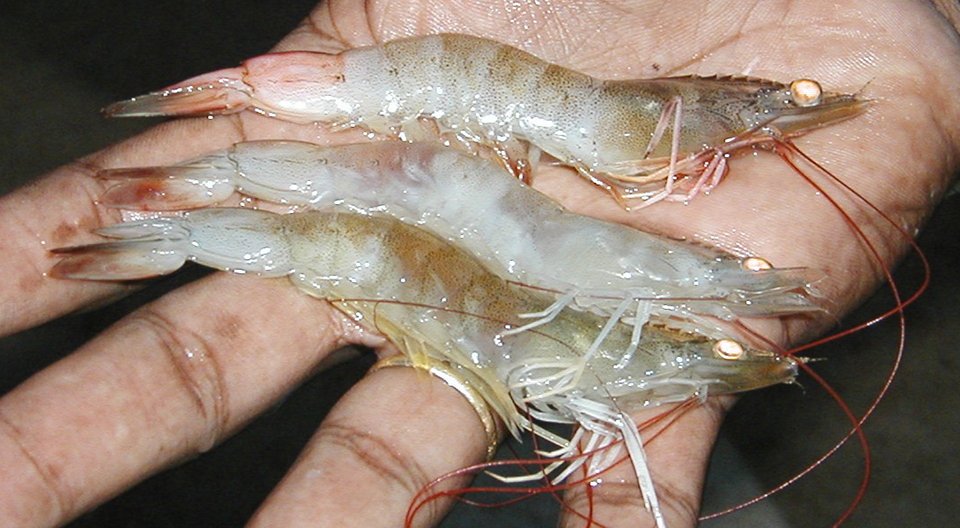
Subadult shrimp display clinical signs of IMN in extensive white necrotic areas of the skeletal muscle in their abdomens. In some shrimp, the necrotic muscle reddens.
Source: globalseafood.org
8. Black Gill
Black gill disease in vannamei shrimp is caused by the genus Fusarium or fungus. Besides fungi, ciliates can also cause black gill syndrome. Black Gill Disease can be caused by the deficiency of ascorbic acid in the diet of the shrimp, as well as possible contaminants in the water – such as cadmium, copper, oil, ammonia and nitrate. High organic load caused by residual feed or debris in the containment area can also cause this, as it leads to high levels of nitrogen in forms that are toxic to the shrimp.
Black gill causes normally white gills to darken in response to the presence of ciliates, the primary agents causing gill melanization, leading to damage to the respiratory surface.
The normal colour of shrimp gills is dull white. In the early stages of black gill disease, black spots appear on the gills. External signs of severely infected shrimp show black gills compared to normal ones.
All gills turn black, with some turning brown, which is the initial stage of black gill infection. The gill lamellae of shrimp infected with black gill show the presence of fungal spores.
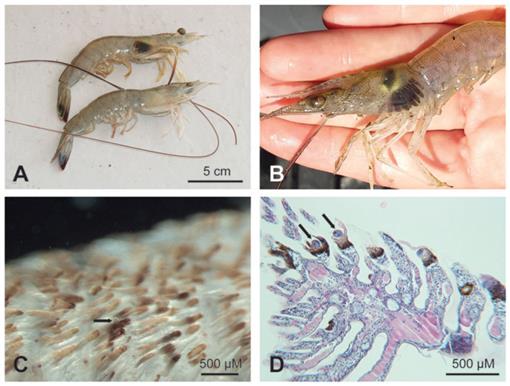
Shrimp black gill. (A) White shrimp (Litopenaeus setiferus) with and without black gill. (B) Gill of white shrimp with severe black gill. (C) Gill tissue from white shrimp with black gill observed under a stereomicroscope. Arrow highlights melanized distal tips of gill lamellae. (D) Hematoxylin and eosin-stained paraffin-embedded histological section (5 µm) of gill tissue from a brown shrimp (Farfantepenaeus aztecus) with black gill. Arrows identify invading ciliates.
Source: bioone.org
The disease causes physical signs such as discoloration or a substance to form on the back side of the shrimps. It can also cause a loss of appetite, difficulty with respiration, secondary infection by pests and can lead to death.
To avoid this, the shrimp must never be overfed. As with other methods, keep the containment area clean and conducive for growing the shrimp.
9. Black Spot
Black spots, also known as black spots, can form on the body of shrimp. Shrimp shells are usually brown and may show black spots. These black spots usually appear after harvesting shrimp, indicating a decrease in shrimp quality.
The cause is a bacterium called Vibrio anguillarum, which thrives in saltwater at temperatures between 25 to 32 degrees Celsius. This bacterium is commonly found in pond environments and does not cause disease if its concentration is kept under control.
However, Vibrio bacteria can become dangerous when water quality in the ponds deteriorates, especially due to the accumulation of organic feed residues at the pond bottom. Decreased pond quality can trigger Vibrio bacterial growth. Additionally, direct sunlight on post-harvest shrimp can also accelerate the appearance of black spots on shrimp.
To prevent this, farmers can regularly clean the pond bottom of waste, including leftover feed and moult residues. They should also maintain water quality by monitoring plankton levels, increasing dissolved oxygen, providing sufficient minerals, and managing feeding to avoid overfeeding, which can make the pond bottom dirty.

A shrimp infected with black spots
Source: Internet
10. Yellow Head
Yellow head disease increases mortality rates up to 100% within 3 to 5 days after infection. The triggering factors are sudden changes in pH and dissolved oxygen (DO) levels. Clinical symptoms usually appear 2-4 days after infection, with death occurring within 3 to 5 days.
Like WSSV disease, this disease is classified as a category C-1 pathogenic virus. Clinical symptoms of the yellow head disease include increased shrimp appetite followed by a drastic decrease until the late stages of the disease, changes in the colour of the shrimp tail to reddish with a yellowish head, and paleness or brownish colouration in the gills.
These signs may not always be visible in infected shrimp; therefore, accurate diagnosis requires gill staining and hemolymph examination and can be further confirmed through RT-PCR.

A shrimp infected with Yellow head disease.
Source: Internet
11. Enterocytozoon hepatopenaei (EHP)
Enterocytozoon hepatopenasei (EHP), also known as EHP disease in shrimp, is a disease caused by the microsporidian parasite. This parasite leads to slow growth in shrimp.
EHP disease in shrimp was first detected in 2004 in Thailand in cultured giant tiger shrimp. In Indonesia, this disease was first reported in 2015.
Although EHP disease does not directly cause shrimp mortality, its impact is felt through a decrease in shrimp growth rate during cultivation. This can result in significant differences in shrimp size within a single cultivation pond.

A shrimp infected with EHP.
Source: Internet
Shrimp are infected by the EHP when they consume contaminated feed and feces from already infected shrimp. A common symptom of the disease is a milky white substance on the abdominal area of the shrimp. While HPM is not scientifically known to cause high death rates in shrimp, it is reported to produce smaller shrimp.
There is no known cure for HPM. An infected pond must be decontaminated thoroughly and chlorine must be added before it is restocked. Due to the extensive measures to be done for decontamination, prevention is the most cost-effective manner to reduce its effects. Farmers must regularly clean and disinfect the pond water and must monitor the presence of EHP in common feed for brood stock. Eggs should also be disinfected by using chlorinated water.
Factors Causing Vannamei Shrimp Disease
1. Pathogen
The most common causes of vannamei shrimp disease are viruses, bacteria, fungi, and parasites. Some examples of conditions in shrimp caused by pathogens include White Spot Syndrome Virus (WSSV), Early Mortality Syndrome (EMS), Infectious Hypodermal and Hematopoietic Necrosis Virus (IHHNV), Taura Syndrome Virus (TSV), and Vibriosis.
The spread of diseases caused by pathogens in shrimp can be transmitted through contaminated water, feed, or equipment and can spread quickly in ponds.
2. Poor Environmental Conditions
Environmental conditions are also directly a factor causing disease outbreaks in shrimp. Poor water quality, high levels of pollutants, and low dissolved oxygen can make shrimp more susceptible to disease.
Not only that, stressful conditions such as drastic and sudden changes in temperature or salinity can also increase the risk of disease in shrimp.
3. Poor Farm Management Practices
Poor pond management is a trigger factor for the emergence of subsequent diseases. This management includes feed, water quality, shrimp health, cultural waste, and biosecurity.
The overall management of this pond management must be synergized and well-practiced. This is because if one is lacking, it will directly impact the shrimp and increase their potential to get sick.
4. Import of Infected Shrimp
Indonesia takes a lot of shrimp fry from other countries, for example, the United States. However, before these imported fries are cultivated, they must first check the quality of the fry to ensure they are not attacked by disease or become carriers.
Imported fry already infected can become carriers for other fries in the same pond. This makes the spread of the disease faster and more massive.
Disease Management in Aquaculture
Treatments for these diseases are limited and costly. While certain antibiotics can be used, the best way to fight disease is to prevent it.
This is best done by ensuring that the water quality is optimal for shrimp growth. Here are three key elements of good water treatment.
-
Track and promote dissolved oxygen levels. Based on microorganism activity, this may require the addition of artificial aeration. Take regular readings, record these readings in a journal or spreadsheet, and act proactively to remediate levels if they begin to decline.
-
Actively eliminate waste build-up. Waste accumulation is significant in pond-style shrimp farming, coming from excess feed, shrimp feces, and dead shrimp carcasses. All of these decaying organic materials can be food sources for the types of pathogenic bacteria or protozoa that cause these diseases. Ammonia is a great mid-season indicator of organic waste levels. Track ammonia levels at least weekly (ideally daily) and act aggressively if numbers rise.
-
Implement and monitor strict biosecurity standards. Physically eliminate contamination through stringent checks on people, water, and equipment shared across ponds. By following these standards contaminants can be excluded, and if they do enter, can be kept contained to small areas.
Probiotics: A tool for proactive disease management
Probiotics, or beneficial bacteria, are a powerful tool to support farmers preventative disease treatments. Through their decomposition of nitrogen and phosphorus, they reduce blue-green algae and other major oxygen competitors – ensuring healthy dissolved oxygen levels. Many species, particularly of the bacillus family, decompose organic waste, serving as a clean-up tool for waste accumulation on pond bottoms. Further, they outcompete many harmful bacteria – such as those mentioned here – for nutrients, greatly reducing their ability to survive and infect the shrimp.
Connect with our team to learn about how our aquaculture probiotics can proactively treat your water, enhance your shrimp immune system, and help you prevent these diseases.
AGRIVINA TEAM.
Source: total box source from the internet.
